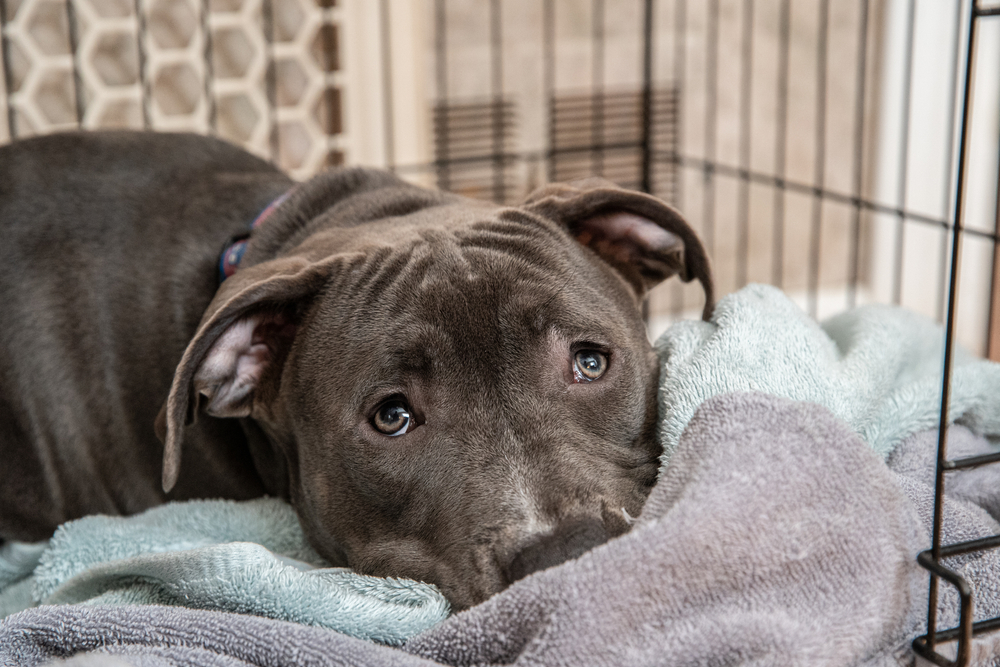Now that you’ve adopted a dog into your family, you’ll want to make them feel right at home. In addition to buying all of the essentials — food, toys, and grooming supplies — you may also want to consider buying a crate. There are several schools of thought. Some believe that crating a dog is cruel. Others believe that, when done correctly, a crate becomes a safe, secure place for your dog and peace of mind for you.

Pros and cons of crating your dog
Choosing to crate train your new family member is a matter of personal preference. Many professional trainers and veterinarians approve of this method, while some animal-rights activists say it’s inhumane.
Pros
- When you’re not home, you won’t have to worry that your dog will chew on furniture or have an accident in the house.
- It’s an effective way to house train. Dogs don’t like to sleep in the same place they potty. Using a crate helps them learn how to control their eliminations when they are inside.
- Crates provide a secure place to keep your dog inside, instead of outside where they might develop bad habits, such as barking or digging, or be subjected to extreme temperatures and other weather-related conditions.
- A crate can act like a den, which many experts believe is part of a dog’s natural instinct, and serve as a safe place for your dog to retreat when he/she is tired or doesn’t feel well.
Cons
- Your dog may cry and whine during crate training.
- Crates that are too small or poorly ventilated can be uncomfortable, creating an undesirable environment for your pet.
- Dogs are social animals and don’t do well when left alone in a crate for long periods of time every day. Long-term confinement can lead to physical and psychological issues such as aggression, depression, muscle atrophy, obsessive licking, and eating disorders.
- Crating isn’t suitable for dogs with medical conditions, especially those that affect bladder control.
How to choose the right crate
It’s important to choose the right crate for your dog if you decide to include this training into their daily routine. Fortunately, you have a variety of options:
- Folding metal dog crates are especially suitable for larger breeds. The wire construction allows for good air flow, and the material is easy to clean.
- Plastic crates are made of durable materials. Many meet requirements for airline travel.
- Foldable fabric crates have mesh ventilation and are especially good for smaller dogs when traveling by car.
- Wooden crates are stylish options that fit into the decorating scheme and often double as functional furniture.
Here are some things to consider:
- Size. Your dog should be able to stand up, turn around, and lie down comfortably in their crate. Any bigger and your dog might use a corner as the bathroom, which defeats one of the major reasons for crate training.
- Ventilation. Whichever style of dog crate you choose, make sure it has adequate ventilation. Larger dogs and those with longer hair may need more ventilation than a smaller pet.
- Duration. Don’t leave an adult dog in the crate any longer than eight hours at a time, four hours for a puppy. Consider finding a doggy day care or hiring a dog walker if you’ll be away for longer periods of time.
- Attitude. Never use the crate as a “time out.” Instead, create a safe retreat for your dog.
- Safety. Make sure you remove your dog’s leash and collar so it doesn’t accidentally become tangled in the crating material.
Other options
If you aren’t interested in crate training your dog but still need a way to monitor their activity on occasion, consider investing in an exercise pen, also known as a playpen. These useful pieces of equipment give your active pup much more room to move around and play, while keeping them close by. For example:
- When you’re outside: A playpen can keep your furry family member close to all of the fun without worry they will wander off or get into trouble.
- When you’re inside: Whether you’re having guests or just need to get a few things done around the house without having Fido underfoot, a playpen can provide ample space for your dog to move around, eat, and drink, and feel like part of the family.
- When you’re traveling: Exercise pens can be the perfect solution for your dog to safely enjoy family time at the campsite or on the beach.
Like crates, playpens come in all shapes, sizes, and materials, most of which can be folded and stored when not in use. Most have interlocking panels of varying heights. You can choose from those with floors and covers to those without. The type of playpen you buy is directly related to the size and activity level of your dog.
Whether you choose to crate train or are looking for an occasional way to safely provide boundaries for your dog, the best solution is one that allows all members of your family — including the four-legged ones — a happy, healthy space in which to live and play.
If you want the best products, you can check out our guide on water dispensers for your dog.



